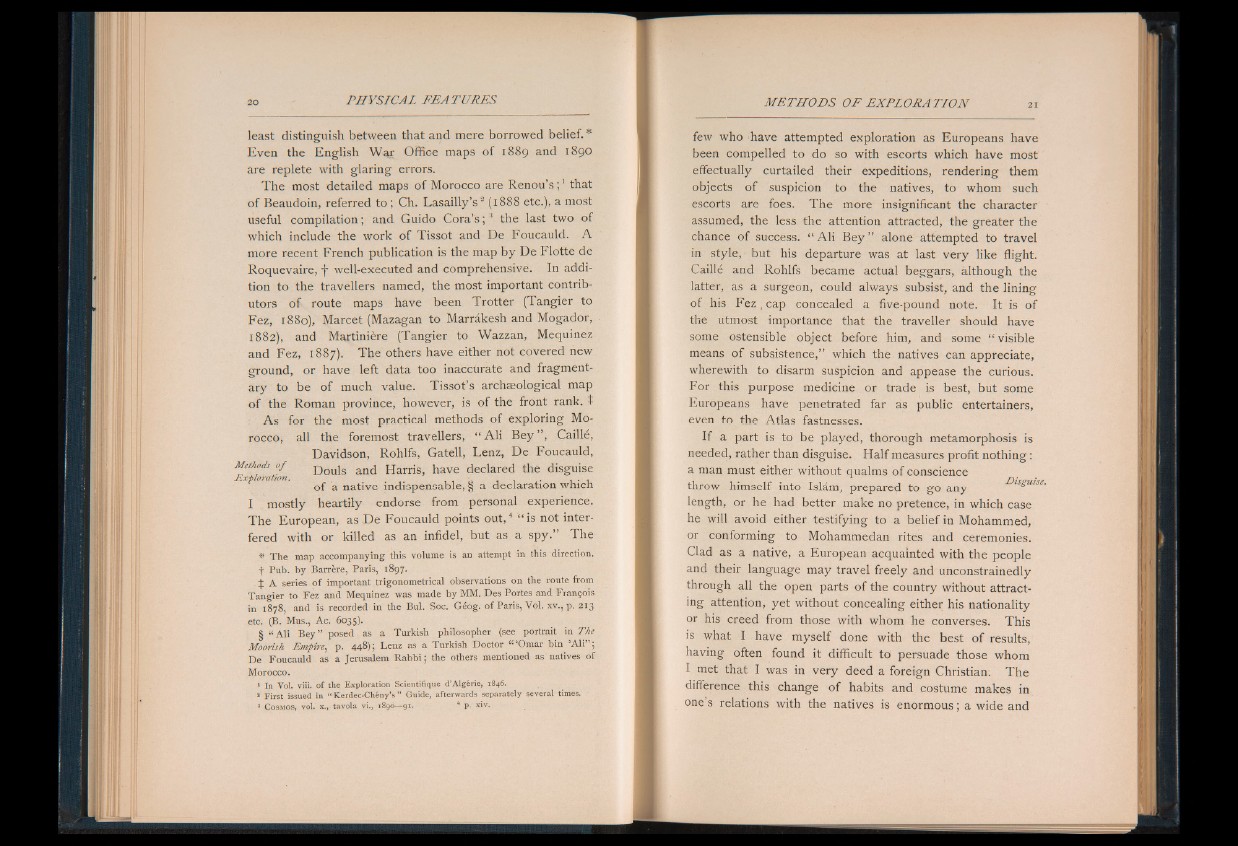
least distinguish between that and mere borrowed belief. *
Even the English War Office maps of 1889 and 1890
are replete with glaring errors.
The most detailed maps of Morocco are Renou’s ; 1 that
of Beaudoin, referred to ; Ch. Lasailly’s 2 (1888 etc.), a most
useful compilation; and Guido Cora’s ; '1 the last two of
which include the work of Tissot and De Foucauld. A
more recent French publication is the map by De Flotte de
Roquevaire, f well-executed and comprehensive. In addition
to the travellers named, the most important contributors
of route maps have been Trotter (Tangier to
Fez, 1880), Marcet (Mazagan to Marrakesh and Mogador,
1882), and Martinière (Tangier to Wazzan, Mequinez
and Fez, 1887). The others have either not covered new
ground, or have left data too inaccurate and fragmentary
to be of much value. Tissot’s archaeological map
o f the Roman province, however, is of the front rank, t
As for the most practical methods of exploring Morocco,
all the foremost travellers, “ A li B e y ” , Caillé,
Davidson, Rohlfs, Gatell, Lenz, De Foucauld,
^Exploration Douls ancl Harris, have declared the disguise
ora ton. ^ ^ native indispensable, § a declaration which
I mostly heartily endorse from personal experience.
The European, as De Foucauld points out,4 “ is not interfered
with or killed as an infidel, but as a spy.” The
* The map accompanying this volume is an attempt in this direction,
f Pub. by Barrère, Paris, 1897.
£ a series of important trigonometrical observations on the route from
Tangier to Fez and Mequinez was made by MM. Des Portes and François
in 1878, and is recorded in the Bui. Soc. Géog. of Paris, Vol. xv., p. 213
etc. (B. Mus., Ac. 6035).
§ “ Ali Bey” posed as a Turkish philosopher (see portrait in The
Moorish Empire-, p. 448); Lenz as a Turkish Doctor “ ‘Omar bin ’A li” ;
De Foucauld as a Jerusalem Rabbi; the others mentioned as natives of
Morocco.
1 In Vol. viii. o f the Exploration Scientifique d’Algérie, 1846.
1 First issued in “ Kerdec-Chény’s ” Guide, afterwards separately several times.
a C o sm o s , vol. x., tavola vi., 1890— 91. 4 p. xiv.
few who have attempted exploration as Europeans have
been compelled to do so with escorts which have most
effectually curtailed their expeditions, rendering them
obj'ects of suspicion to the natives, to whom such
escorts are foes. The more insignificant the character
assumed, the less the attention attracted, the greater the
chance o f success. “ Ali B e y ” alone attempted to travel
in style, but his departure was at last very like flight.
Caillé and Rohlfs became actual beggars, although the
latter, as a surgeon, could always subsist, and the lining
of his F e z , cap concealed a five-pound note. It is of
the utmost importance that the traveller should have
some ostensible object before him, and some “ visible
means o f subsistence,” which the natives can appreciate,
wherewith to disarm suspicion and appease the curious.
For this purpose medicine or trade is best, but some
Europeans have penetrated far as public entertainers,
even to the Atlas fastnesses.
If a part is to be played, thorough metamorphosis is
needed, rather than disguise. Half measures profit nothing :
a man must either without qualms of conscience
throw himself into Islam, prepared to go any
length, or he had better make no pretence, in which case
he will avoid either testifying to a belief in Mohammed,
or conforming to Mohammedan rites and ceremonies.
Clad as a native, a European acquainted with the people
and their language may travel freely and unconstrainedly
through all the open parts of the country without attracting
attention, yet without concealing either his nationality
or his creed from those with whom he converses. This
is what I have myself done with the best o f results,
having often found it difficult to persuade those whom
I met that I was in very deed a foreign Christian. The
difference this change o f habits and costume makes in
one’s relations with the natives is enormous ; a wide and